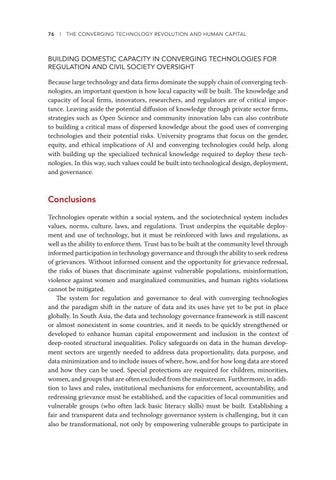76 l THE CONVERGING TECHNOLOGY REVOLUTION AND HUMAN CAPITAL
BUILDING DOMESTIC CAPACITY IN CONVERGING TECHNOLOGIES FOR REGULATION AND CIVIL SOCIETY OVERSIGHT Because large technology and data firms dominate the supply chain of converging technologies, an important question is how local capacity will be built. The knowledge and capacity of local firms, innovators, researchers, and regulators are of critical importance. Leaving aside the potential diffusion of knowledge through private sector firms, strategies such as Open Science and community innovation labs can also contribute to building a critical mass of dispersed knowledge about the good uses of converging technologies and their potential risks. University programs that focus on the gender, equity, and ethical implications of AI and converging technologies could help, along with building up the specialized technical knowledge required to deploy these technologies. In this way, such values could be built into technological design, deployment, and governance.
Conclusions Technologies operate within a social system, and the sociotechnical system includes values, norms, culture, laws, and regulations. Trust underpins the equitable deployment and use of technology, but it must be reinforced with laws and regulations, as well as the ability to enforce them. Trust has to be built at the community level through informed participation in technology governance and through the ability to seek redress of grievances. Without informed consent and the opportunity for grievance redressal, the risks of biases that discriminate against vulnerable populations, misinformation, violence against women and marginalized communities, and human rights violations cannot be mitigated. The system for regulation and governance to deal with converging technologies and the paradigm shift in the nature of data and its uses have yet to be put in place globally. In South Asia, the data and technology governance framework is still nascent or almost nonexistent in some countries, and it needs to be quickly strengthened or developed to enhance human capital empowerment and inclusion in the context of deep-rooted structural inequalities. Policy safeguards on data in the human development sectors are urgently needed to address data proportionality, data purpose, and data minimization and to include issues of where, how, and for how long data are stored and how they can be used. Special protections are required for children, minorities, women, and groups that are often excluded from the mainstream. Furthermore, in addition to laws and rules, institutional mechanisms for enforcement, accountability, and redressing grievance must be established, and the capacities of local communities and vulnerable groups (who often lack basic literacy skills) must be built. Establishing a fair and transparent data and technology governance system is challenging, but it can also be transformational, not only by empowering vulnerable groups to participate in

